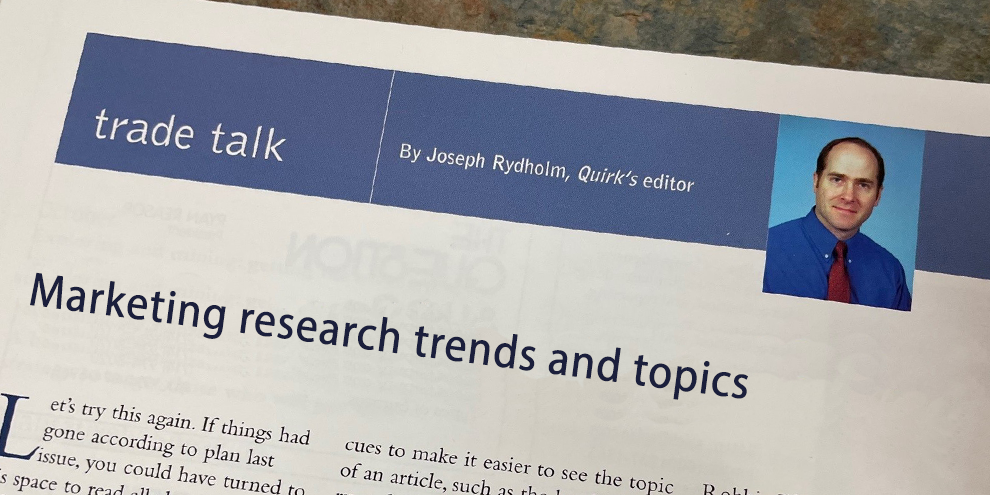It’s been five years since my last visit to a Qualitative Research Consultants Association annual conference and nothing has changed - thank goodness. At the QRCA gathering in San Diego in 2000, I marveled at the willingness of these independent moderators - who could rightly view each other as competitors - to share their hard-earned expertise during conference presentations.
The same spirit was on display in October at the group’s 2005 meeting at the Beverly Hilton in Los Angeles . On the first day, Renee Fraser, CEO of Fraser Communications, Santa Monica , Calif. , gave a fun, frank talk on work that her firm did with the Frederick ’s of Hollywood brand. The lingerie maker had a host of challenges facing it, including emerging from a 2000 bankruptcy filing and increased competition from Victoria ’s Secret. In spite of the bankruptcy, the company began a comprehensive research effort in 2001 to re-brand itself and better understand its customers and non-customers alike. Qualitative research was helpful in many ways. It reaffirmed the importance of product quality and gave Frederick ’s valuable insights into the language and psychology surrounding the wearing of lingerie.
Fraser also did anonymous in-depth telephone interviews with Frederick ’s employees to tackle a number of crucial questions: What are the strengths/weaknesses of the brand? Who are the main competitors and what are their strengths and weaknesses? What are employee perceptions of Frederick ’s customers? What internal changes need to be made to “de-silo” the company? A company retreat also helped air internal disagreements and get the employees working from the same set of shared assumptions (different groups within the firm, for example, held different views of the customers).
Along with the wide-ranging case history Fraser also imparted some good advice for researchers of all stripes, whether vendor or client: always offer a point of view or perspective along with the research results; provide solutions to problems, not just descriptions of problems; think of yourself as a marketing or business consultant with your own practice - insights and understanding are what you create and deliver.
Other conference highlights included a wide-ranging overview of the packaging research process from Lauren Goldberg of Perception Research Services, Fort Lee , N.J. , and a highly interactive session on perceptual mapping led by Pat Sabena and her daughter Nicole Sabena Feagin of Westport, Conn.-based Sabena Qualitative Research Services. These sessions perfectly captured the spirit of the QRCA conference. In the latter, the two presenters went through a series of hands-on demonstrations of mapping approaches for use during focus groups such as hierarchical maps, bull’s-eye maps and quadragrids, all while fielding questions from the large, enthusiastic audience. It was open and stimulating and extremely informative.
A bit of Hollywood
Given the L.A. setting, it was only fitting to have a bit of Hollywood on the program. (As if gawking at Desperate Housewives Eva Longoria, Marcia Cross and Felicity Huffman, who were attending a charity event in the hotel ballroom one of the evenings, wasn’t enough.) Kevin Goetz, managing director, executive vice president of entertainment research for Los Angeles research firm OTX (Online Testing Exchange), spoke about his firm’s integral role in conducting research on the movies we see.
In addition to testing movie trailers, TV and print ads for upcoming releases, and tracking films after they are released, OTX also conducts preview screenings and post-screening focus groups, which are frequently observed by A-list actors, directors and producers.
Being a film nut, I was enthralled from the beginning and could have happily listened to Goetz, a natural presenter who mixed in a little movie biz dish here and there, talk for hours. After the first five minutes I thought he had a dream job. I mean, marketing research and movies - what could be better? But as he detailed the various problems he has to deal with in each movie focus group, from pleasing the prima donna director who gripes if his nonfat soy half-caf mocha latté isn’t perfect to scanning the movie preview crowds for potential video pirates, I almost felt bad for the guy. Almost.
While Goetz never answered the burning question of just how in the world do so many awful movies get made, he did illustrate why the lowly focus group has achieved star status in Hollywood . To be sure, the method is much-maligned, just as it is in the real world. But while the moviemakers may not always like what they hear, they must recognize that there’s really no other way to find out firsthand what members of their intended audience think of their creations. | Q
